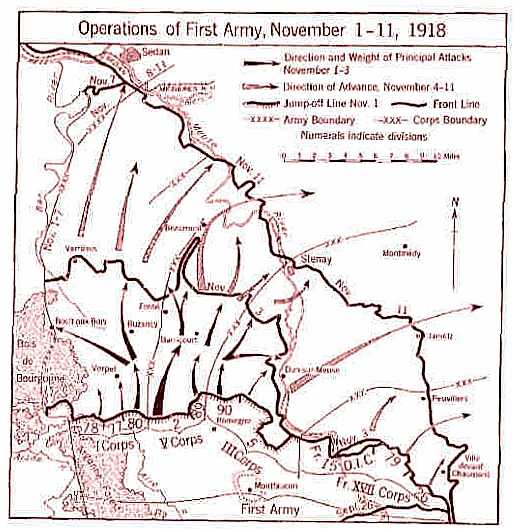Using new tactics, and the experience afforded to veterans of a long war, the German Army made massive gains that had not been achieved since 1914. The French Armies were now in full retreat across the Allied lines and headed toward Paris and away from the German juggernaut.
The only thing that stood in Germanyís way was the American Expeditionary Forces at Belleau Wood. The German advanced was checked by the Marines and soldiers at Belleau Wood, allowing time for the French forces to reform. The Americans sounded the bugle call that would bring the French Army back on its feet.
During the summer of 1918, the Allies were back on their game as the French and British Forces quickly patched up their wounds and remade a new line that was now getting dangerously close to Paris. The first order of business was to snub out the St. Mihiel salient that was poking out like an angry thorn into the side of the Allied line.

This fell squarely into the Americans sandbox as they went into their first real front line action. By September of 1918, the Allied line finally regained some of its territory that it had lost to the German advance earlier in the year.
Though the Allies didnít know it, Germany was now in the corner. Everything was much the same as it was a year ago, with one vital exception. There was a whole new Army on the southern flank of the Western Front. The American 1st Army was under General Pershing and now the Allies felt it was time to make good on its new numerical superiority.
Using several ruses to deceive the Germans into thinking the offensive would head toward Metz in the north, the US 1st Army began to form in the area between the Meuse River and the Argonne Forest.
At 5:30 on the afternoon of September 26th, the American 1st Army jumped off with the French holding their flanks. Following a rolling barrage of artillery fire, the US 1st Army crashed through the German defences. The US 3rd Corps pushed its way into the German's second defensive line but the 5th Corps got stopped at Montfaucon during the first day.
The Germans rushed six divisions into the line to try to plug the hold. By the end of the day, the US Army had not gotten very far, but in the overall theatre of war, it didnít need to.

Up in the north, the British Armies under General Plumer were now beginning their own push into German territory. Due to the deteriorating situation that the Americans had produced, they had recaptured the Passchendaele Ridge which they so bloodily lost the year before.
To Erich Ludendorff, the situation was turning from bad to worse. He now found himself trying to plug all the holes in the line and with no forces left to plug them with. By October 6th, three British Armies smashed their way to the Hindenburg line, the last German line of defence, but they were to spent to make past it. At around the same time, General Pershing took his most veteran divisions and squeezed out Montfaucon and tried to restart the offensive.
General Pershing now had to get through the Argonne Forest to get to the breakout which the Allies wanted and needed. However, the Germans threw a brick wall in the way of the American advance in the Argonne Forest. The 77th Division took a heavy toll in the Argonne Forest and now the Germans threw everything they had left into holding the US 1st Army back. The 28th Division was having a better day and instead went down the Aire Valley and captured Varennes.
The Germans had nothing left in reserve now to strengthen the line, and now the Allies were putting more and more pressure into the battle. Feeling instead of knowing that this time, the end was near.
Time was now working on the side of the Allies, for every day the Germans tried to hold their line, more and more Allied Divisions were going into the fray. Erich Ludendorff, now reported to the Kaiser that it was now lost and to sue for peace. The British Armies, now backed by the French were banging on the front door and the Americans were about to crash through the back door.
By the beginning of November, the American 1st Army was still blocked by the Argonne Forest which was being held staunchly by the Germans, even though everywhere else the line was finally buckling to the Allied onslaught.
At 11:00 AM on November 11th, the battle ended with the signing of the cease fire and the Armistice. The US 1st Army by that point had bludgeoned its way around the Argonne Forest and made its way to the Hindenburg line and was about to open another operation toward Metz.
What was the effect of the US involvement during this campaign? Well, it was drawn down to simple numbers and the fact that the Germans couldnít be everywhere at once. The Americans began the first of several advances that first pushed back, then broke the German line in the Western front. What the Allies were trying to achieve in over four years of brutal trench warfare, the Americans had done in only two months.
The American Army had become the anvil to the Allied hammer blow in the Western Front. By the end of the Meuse-Argonne offensive, there were 1.3 million American troops on French soil that were in the front or heading to it."
Note: Information taken from an article by Thomas Smith, found at www.firstworldwar.com.